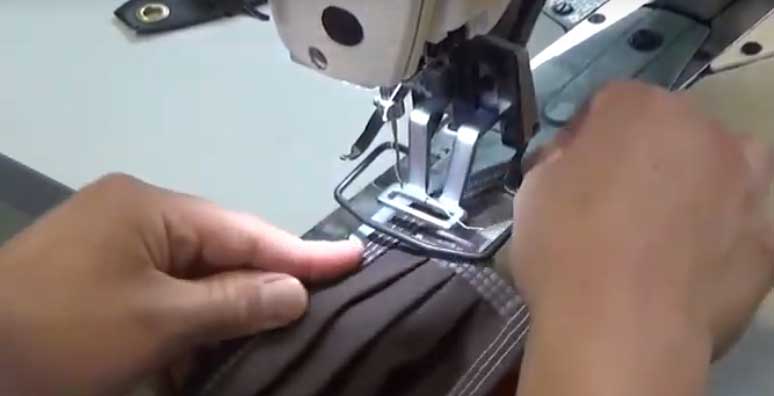Inmates Use Pedal Power to Slow the Spread of COVID-19
When COVID-19 entered the picture, immediate consideration was taken for our vulnerable custody environment, which holds not just our inmate population, but thousands of sworn and civilian personnel, and medical staff. With roughly 17,000 inmates cycling through seven custody facilities and thousands of employees interacting with them, immediate action was necessary to protect the health of all.
Custody Assistant Sue Tupper is the sewing instructor who oversees the Century Regional Detention Center (CRDF) sewing program. She teaches interested females housed there to imagine, cut and follow sewing patterns, and create things which are not just useful, but detailed, functional and pretty. Officer Tupper explains the differences between the English and metric measuring systems, defines various sewing terms, demonstrates the use of different applications, and outlines the different kinds of sewing machines and their capabilities.
Deputy Christine Badaracco, assigned to North County Correctional Facility (NCCF), oversees the male inmates in the sewing shop where they produce all the inmate uniforms for the Department. They have one sewing instructor and more than 280 sewing machines. The men sew clothes but also mend various Department assets to keep them in good shape and extend their use, and create new pieces of equipment, like holster bags. Some of the more experienced men learn upholstery and other specialty work, which can be useful and even lucrative on the outside, such as custom items, custom-covered furniture, boat canopies, and car covers. Their goal is to teach the inmates a valuable vocation as a skill for life, so they can find work on the outside, make money to support themselves and, hopefully, not return to jail.
When COVID-19 began to affect the jail system, Deputy Badaracco and Officer Tupper took the health crisis as an opportunity to do something good with benefits, which came two-fold. On Friday, March 27, 2020, Officer Tupper crafted a prototype fabric face mask and taught inmates how to sew them, too. That day, they made 33 of them. In a short time, the creations increased in numbers, and became helpful precautions against spreading the virus through droplets from sneezes, coughs and everyday speech. Employees and inmates who wear them are slowing the spread, and inmate-students who made them learned a new and beneficial project.
The masks were initially created for CRDF inmate workers with assignments as trustees and kitchen workers. Now, the majority of women there have a mask, with the goal of providing each inmate within our jail system with at least two masks. When an inmate is released, they may keep their mask, to encourage them to practice personal safety measures. So far, the women created more than 1,200 masks and continue to produce them, cranking out an impressive 100 pieces in an eight-hour shift!
An average of ten females are assisting Officer Tupper in the production, alongside a half-dozen staff who help speed production by preparing the material and cutting it into patterns. Whether inmate or employee, everyone involved in the mask project sees this as a basic human need and takes great pride in participating. The project grew so much in popularity, inmates are waiting to be selected to help!
Officer Tupper puts her heart into her work and teaches with an earnest desire to see her pupils’ success. “You put your best foot forward so that, if even one person makes it, it was worth it,” she said.
The CRDF sewing shop has five industrial sewing machines and ten domestic machines, which were donated. The material also comes from donations or from scraps from the North County Correctional Facility (NCCF) sewing shop, where they produce the inmate uniforms. Since Tuesday, April 7, 2020, the CRDF mask-producing enterprise was in conjunction with male inmates at NCCF.
Deputy Christine Badaracco and vocation instructors at NCCF have trained 15 inmates to put the pattern pieces together and sew them into a complete product. With a staff of five, they work side-by-side with inmates in a fluid production line: Cut material into squares, fold three pleats and baste, heat-press the pleats, sew the edges with bias tape to create tie-strings, snip to separate, and box them up. Because there is no elastic in the masks and they don’t stretch, they are crafted into two different sizes to accommodate large and small faces. The favored material at that facility for making masks is the brown material used to sew clothes for inmates housed in the medical ward because it is softer. So far, they made more than 3,000 and are making more every day. The men, who normally sew clothing, enjoy the change of pace in making something different, and like the sense that they are contributing to others’ health and wellness.
Personnel assigned to Custody Division were given N95 masks and are using them if they do not have a surgical, dust or fabric masks. The hand-crafted masks will be made available to staff, as well, but not until all inmates have a mask or have access to one.
Before the mask movement, male inmates in the NCCF sewing shop learned their sewing skills on the heavier-duty material to keep the jail population clothed. Female inmates in the CDRF sewing shop used the heavier-duty material from the inmate uniforms to create tote-bags for wheelchairs, walkers and crutches. More delicate material was used to make quilts and stuffed toys; the tote-bags, quilts and toys were donated to a variety of outlets, including children participating in the 999 for Kids program and the Special Olympics.
As each facility is unique, so may be their circumstances. Although there are 75 inmate-students at NCCF, no more will be trained to sew masks, as staff wish to avoid compromising the others from becoming ill or infected. For now, though, we press forward together for the wellness and betterment of all, and hope for a quick ending to the COVID-19 pandemic.


